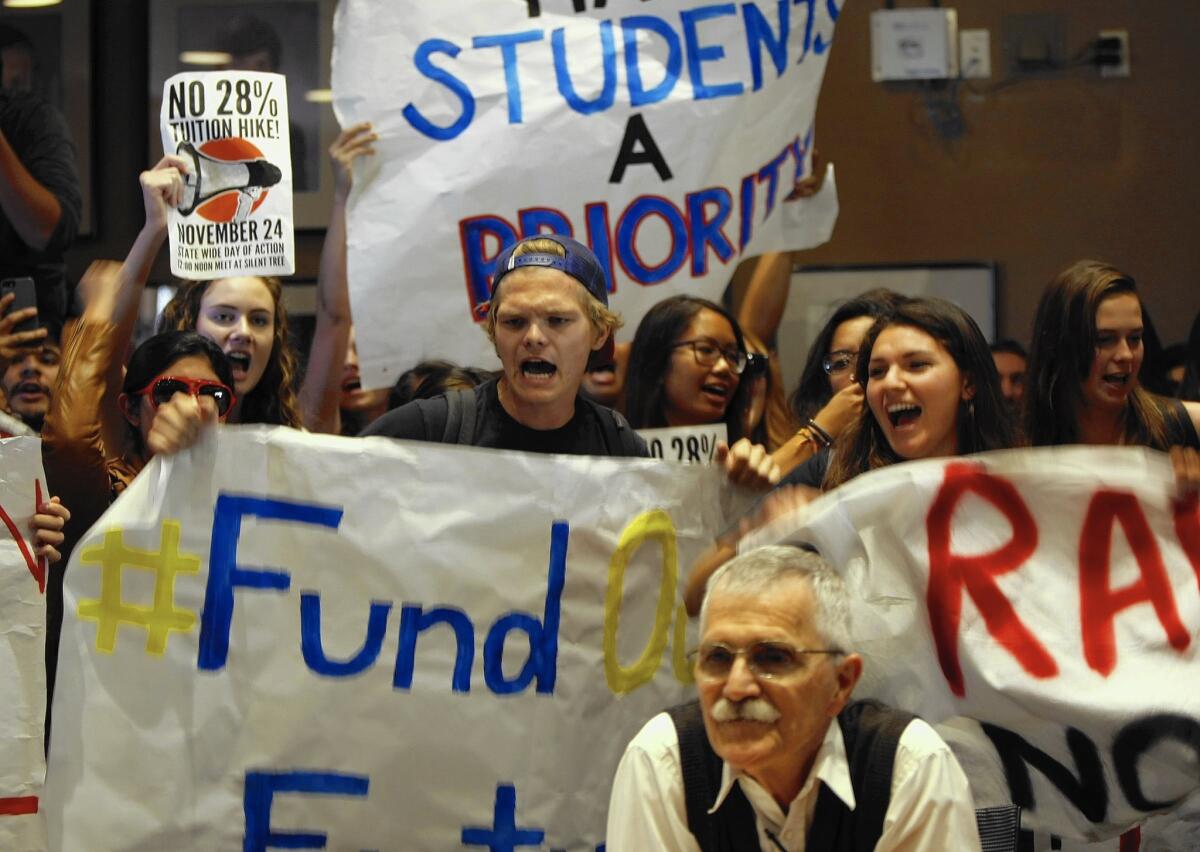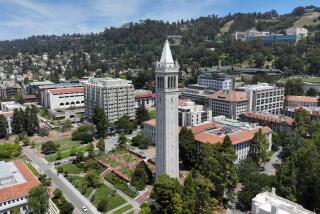Is UC spending too little on teaching, too much on administration?

- Share via
Fifty years ago, the University of California basked in a golden moment: With the state booming, the system opened two new campuses in 1965, one on the old Irvine Ranch in the middle of Orange County, the other in the hills above Santa Cruz and the Pacific Ocean.
It was a crowning achievement for then-Gov. Pat Brown, who made expanding the system a top priority.
Today, UC has 10 campuses across the state and a $27-billion budget. But there is a persistent debate about how the university spends that money and whether students are being shortchanged.
Weeks after an announced increase in state funding staved off a tuition hike, the Board of Regents riled spending critics this summer by handing 3% raises to some of UC’s highest-paid employees. The number of those making at least $500,000 annually grew by 14% in the last year, to 445, and the system’s administrative ranks have swelled by 60% over the last decade — far outpacing tenure-track faculty.
Administrative growth and executive compensation are perennial hot-button issues for students, labor leaders and fiscal watchdogs, who say they are emblematic of the system’s free-spending ways. UC officials counter that the costs are necessary to compete with other world-class institutions and keep up with advancing technology and growing enrollment.
They also say the budget numbers can give the wrong impression.
Only about a quarter of the UC system’s budget is made up of “core fund” spending on the educational mission, they point out. The remainder encompasses everything else, including five medical centers that are more than self-supporting and the Lawrence Berkeley National Laboratory, which helps bring in the billions of dollars in government grants and contracts that UC researchers attract each year.
Indeed, UC’s budget — larger than those of some 25 states — is so big and so complex that it can be puzzling even for experts.
“The challenge is to sort of get your arms around everything that they’re doing and all of their funding sources and how they spend their money,” Paul Golaszewski, principal fiscal and policy analyst with the nonpartisan Legislative Analyst’s Office, told an Assembly panel examining UC spending earlier this year.
The budget drew increased scrutiny this spring, when Gov. Jerry Brown squared off with UC President Janet Napolitano over her bid to raise tuition by as much as 28% over five years to cover payroll and retirement costs, hire more faculty and enroll more California undergrads. Brown opposed the hikes, calling instead for cost-cutting efforts such as more online courses and shorter graduation trajectories.
The two struck a deal in May that boosted state funding, froze in-state undergraduate tuition for two years and required UC to reform its pension plan for future participants.
For two decades starting in 1990, the regents allowed the system and its employees alike to stop contributing to the plan, which was overfunded at the time but now has a $12-billion unfunded liability, according to UC’s latest operating budget. Despite warning signs as early as 2005 that the fund was headed for trouble, it was not until 2009 that the regents acted to resume contributions the following year.
UC now must spend about $1.3 billion a year to cover its pension costs — and it will take decades to fill the gap. That draws money away from other uses, said Adam Tatum, until recently the research director of California Common Sense, a nonprofit, nonpartisan think tank.
“Now, it is not going to salaries; it is going to retirement benefits that should have already been paid for, or at least set aside for,” said Tatum, who now works for a financial services firm. “It is not going to UC campuses, but to past debts that should have been paid and would have been paid if UC had not participated in that pension contribution holiday.”
Despite its immensity, the pension problem has attracted relatively little public attention compared with administrative growth and the big salaries and perks that often come with it.
Some UC students contend that, even as the administration has grown, their educational experience has declined.
“Class sizes are ridiculous and desks are broken,” said Rebecca Ora, a doctoral candidate in film and digital media at UC Santa Cruz and treasurer of the University of California Student Assn. “Where is the spending on education?”
UC officials flatly reject any contention that they have drifted from that core mission. They note that enrollment has grown by 77,000 in the last 15 years and that UC has kept its commitment to find a spot on one of its campuses for all California high school students graduating in the top 9% statewide or within their own classes.
“We have doubled down on our mission,” said UC spokeswoman Dianne Klein. “The fact that UC still manages to be among the very best public or private universities in the world — despite the dramatic cutbacks in state support — speaks to the dedication of our faculty, students and staff.”
Tuition has been a contentious issue in the state since 1960, when the California Master Plan for Higher Education called for the state’s public community colleges and universities to be affordable and accessible to residents.
In 1980, UC’s in-state undergrads paid $719 a year in tuition and fees. By 1994, the figure had grown to $3,800, but stayed relatively flat for most of the next decade. By the mid-2000s, on the heels of a state budget crisis, tuition had jumped by more than 40%, topping $5,000.
Class sizes are ridiculous and desks are broken ... Where is the spending on education?
— Rebecca Ora, a doctoral candidate in film and digital media at UC Santa Cruz
It has since more than doubled, to about $12,200, while state funding in real dollars is less than its 2000 level. Out-of-state students, whose numbers have risen in recent years, pay about $23,000 more per year and have helped offset state funding cuts.
As total enrollment has grown, from about 126,000 in 1980 to more than 246,000 now, UC’s spending has likewise ticked upward. Even the Great Recession didn’t stop the growth. Overall spending grew by 40% from 2007-08 to 2014-15, a state Assembly subcommittee report noted, from $19.2 billion to $26.9 billion, including hospitals and federal energy lab. Core fund expenditures for basic education rose 27% during the same period, from $5.4 billion to $6.9 billion.
The “lion’s share” of increased spending since 2007 has been due to growth in the university’s health sciences system, which includes the revenue-generating medical centers and is self-supporting, said Nathan Brostrom, UC’s chief financial officer.
The rise of non-teaching and non-research jobs at private and public universities has become a hot topic on campuses from coast to coast.
Efficiency experts brought in to assess the UC Berkeley bureaucracy a few years ago concluded it was top-heavy. Bain & Co. consultants tallied 11 layers of management between the chancellor and front-line employees, suggesting that the organization had too many bosses. More than half of all managers — about 1,000 — had three or fewer direct reports, and 471 were in charge of exactly one person each.
Depending on the work involved, and compared to similar organizations in private industry, the consultants said, the average number of direct reports per supervisor should have been in the range of six to 11.
Too few direct reports per manager and too many administrative layers resulted in slower decision-making, excessive costs and lower employee morale, Bain experts concluded.
UC responded to that and other findings with a broad — and controversial — multiyear effort to cut costs by about $75 million annually by streamlining operations and administration.
NEWSLETTER: Get the day’s top headlines from Times Editor Davan Maharaj >>
Other UC campuses have launched similar efforts, even as the number of high-paying jobs has grown.
More than 900 UC employees — many of them doctors whose compensation includes payments from insurance, Medicaid and other sources — are paid at least $400,000 a year, nearly twice as many as in 2010 and more than six times as many as in 2004.
UC officials say that well-paid administrative positions are essential to meet rising information and technology demands, the increasingly complex requirements of government funding and regulation and other 21st century needs. Many of those jobs are IT managers, architects, engineers and fiscal analysts, officials say.
They also note that only about 3% of UC’s 195,000 employees earn more than $200,000 a year. Most of those are faculty members in health sciences who work at teaching hospitals and are paid largely from clinical revenue and research money, not state funds, they say.
While big paychecks for those in UC’s senior management group — including the president, the chancellors and other top administrators — attract the most attention, they comprise less than 1% of the $27-billion budget, officials say.
It is the next layer of well-paid administrators that has grown most significantly over the last two decades. From 2004 to 2014, the management and senior professionals ranks swelled by 60%, to about 10,000, UC data show.
“There is a huge cadre of middle managers and upper middle managers, and that is where the bloat is,” said Charles Schwartz, a UC Berkeley physics professor who retired in 1993 and has spent much of his time since then crunching the budget and issuing a series of sharp critiques.
Administrators now outnumber tenure-track faculty members, whose ranks, over the same decade, grew by just 8%, from 8,067 to 8,722, and have not kept pace with rising enrollment.
As more of the teaching burden has shifted to adjunct and part-time instructors, students say their face time with tenured professors has shrunk and their class sizes have grown.
Brostrom, UC’s chief financial officer, acknowledged such problems but said student-faculty ratios and crowded classes are not a function of increased spending on administration but rather of declining state funding over the last 15 years.
“During that time we’ve added 80,000-plus students and a new campus,” he said, referring to UC Merced.
Testifying before the budget panel earlier this year, Brostrom said the numbers don’t always tell the whole story. He cited the example of adding lawyers at the UC president’s office, its Oakland headquarters: On paper the numbers grew, he said, but the move saved money by bringing legal work in-house instead of farming it out.
In other instances, however, the opposite occurred: Numbers shrank but costs grew.
According to the subcommittee report, the president’s office cut its staff from 1,900 in October 2007 to 1,684 in October 2014. But the number of employees in the two highest-paid groups there grew by about 27%, from 573 to 725, during that time. The office budget in 2014 rose to $625 million, up from $587 million three years earlier.
Arguing against the tuition hike, the famously frugal Brown said students would not have to pay more if the university system spent less. He also has criticized its outsized salaries.
“Money doesn’t buy everything in this world,” he told his fellow regents in December. “If it did, I wouldn’t have anybody working for me.”
Officials say they must compete for top talent, in part to maintain UC’s role as a major economic driver. It is the state’s third-largest employer, and one UC-commissioned study pegged its annual contribution to California’s economy at $46 billion.
See the most-read stories this hour >>
UC bases its salaries on proprietary market surveys and other factors, including comparisons to Fortune 500 companies, a process criticized by labor leaders and others as deliberately opaque. Some also question whether UC, as a public institution, should be trying to compete with private industry.
UC officials say they also must compete for the best faculty, noting the 61 Nobel laureates in its current and past ranks.
“No other public institution can claim as distinguished a group of individuals,” its 2015 Accountability Report boasts.
While faculty salaries generally are smaller than senior administrators’, the rationale is the same. Faculty compensation is based on comparisons with four elite private universities and four top public institutions: Harvard, MIT, Stanford, Yale, Illinois, Michigan, SUNY-Buffalo and Virginia.
UC says its professors’ pay lags behind the competition’s by some 12%.
Golaszewski, of the Legislative Analyst’s Office, is among those who have questioned the competitive comparisons.
“You are a public university; should you really be comparing yourself to a very wealthy private university?” he said in an interview during the budget fight, adding that his research did not support UC’s fears of losing top talent to higher-paying schools.
“They always bring up the anecdote about how they lost some Nobel laureate or professor to some other university and say, ‘Oh, no, UC is in trouble,’” he said. “It just didn’t seem like a very pervasive problem.”
Brostrom said many stay at UC out of a sense of public service. “If you look throughout UC, you will see a lot of people working for lower salaries than what they could be getting at private institutions or other places,” Brostrom said.
“A lot of faculty and top administrators choose to stay at UC because of the public mission — and they choose to do it at lower salaries,” he said.
MORE ON EDUCATION:
Teacher Rafe Esquith’s misconduct investigation is a high-profile test for LAUSD’s ‘tiger team’
Goodbye and good riddance to California’s high school exit exam
‘Redskins’ ban angers fans of California schools still using the mascot
More to Read
Sign up for Essential California
The most important California stories and recommendations in your inbox every morning.
You may occasionally receive promotional content from the Los Angeles Times.











